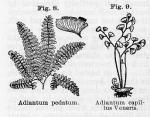Adiantum.—Maidenhair.

 The whole plant of the Adiantum pedatum, Linné, and Adiantum capillus Veneris, Linné.
The whole plant of the Adiantum pedatum, Linné, and Adiantum capillus Veneris, Linné.
Nat. Ord.—Filices.
COMMON NAMES.—Maidenhair, Maidenhair fern.
Botanical Source.—The American species of Adiantum is a delicately beautiful and graceful fern, growing from 6 to 15 inches high, with a handsome, polished, dark-purple or black stipe, forking at the summit; each branch so created supporting simple branches densely clothed with alternate, triangular, oblong pinnae. These are entire and veined on their lower margin, incised on their upper border, and fruit-bearing. The fruit dots are short, slightly crescent-shaped, and marginal, and covered by an indusium derived from the reflected margin of the lobe. The fronds are erect and present a beautiful appearance. The leaves are slightly bitter, together with a faintly sweetish, aromatic, feebly astringent taste. The odor is delicately aromatic.
The European species is about 1 foot high, with a brownish or brownish-black stipe, pinnate above, and doubly or thrice pinnate below. The leaflets are irregular, wedge-shaped, obtusely incised, with the fruit dots in a marginal line. It is inodorous, with a sweetish taste, afterward slightly bitter, and feebly astringent.
History and Chemical Composition.—The maidenhair ferns contain a volatile oil, sugar, tannin, mucilage, and a bitter principle. The A. pedatum is a common fern in the moist, rich soil of the American woods, and is found also in Eastern Asia. The A. capillus Veneris is a native of Europe, but, according to Englemann, is naturalized in Florida, Texas, and Arkansas, and westward to California. The European species is used in preparing a syrup called Sirop de capillaire, which is popular in France and Germany as a mucilaginous pectoral. The plants yield their virtues to boiling water, and are used in decoction, infusion, or syrup.
Action, Medical Uses, and Dosage.—Maidenhair is refrigerant, expectorant, tonic, and subastringent. In decoction it forms an elegant refrigerant drink in febrile diseases and in erysipelas, and is also beneficial in coughs, chronic catarrh, hoarseness, influenza, asthma, etc. It is likewise reputed efficacious in pleurisy, and in jaundice.The decoction or syrup may be used freely. These plants are highly valued by some practitioners, and deserve investigation. Doses: Decoction (℥j to aqua Oj), dose, 1 to 4 fluid ounces. Infusion (℥j to aqua Oj), dose, 1 to 4 fluid ounces. Syrup (adiantum 1 part, boiling water 10 parts, sugar 19 parts; infuse, adding the sugar after the syrup has been strained), dose, 1 or 2 tablespoonfuls.
Related Species.—Asplenium Adiantum nigrum, Linné. Black maidenhair. Habitat, Europe. Mucilaginous. Substituted for the true maidenhairs.
Asplenium Trichomanes. Spleenwort. Europe. Also used to adulterate the true species. Neither of the foregoing have, however, the aromatic flavor of the genuine article.
Asplenium ruta muraria, Linné. White maidenhair. Indigenous to both Europe and the United States. Used for the same purposes as the medicinal fern.

